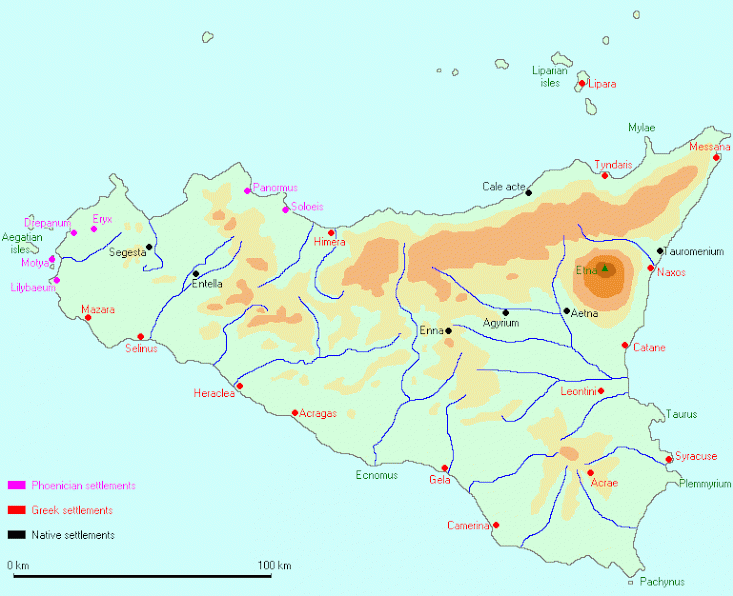Ducetius
Ducetius (†440 BCE): native Sicilian leader who founded a state similar to that of the Greek tyrants on his island.

The story of Ducetius is told by Diodorus of Sicily, a Greek historian of the late first century BCE. He uses an earlier source that can be identified with Timaeus of Tauromenion, again a Greek author. The inevitable result is, of course, that Diodorus' story is told from a Greek perspective. Ducetius is presented as a national leader of the native population of Sicily, the Sicels, and his career is seen as some sort of insurrection against the Greek settlers. This is probably incorrect. Ducetius' successes were possible because he copied Greek methods. He did not resist Greek culture, but was part of it.
Among Ducetius' examples must have been the famous tyrant of Gela and Syracuse, Gelon. Together with Theron of Acragas he had started to unify the Sicilian towns in two big territorial states. In 480, the two tyrants had defeated their main opponents, Terillus of Himera and his Carthaginian ally Hamilcar, near Himera. One of Gelon's instruments to divide his opponents and tighten his grip on conquered territories had been to resettle people in newly founded towns. It had been very successful and although Gelon had died in 478, his brother Hiero continued this policy. After Hiero's death in 467, Syracuse became a democracy.
There were some accompanying troubles, for example when war broke out between Syracuse and its former colony Catana. In 461/460, the Syracusans attacked the settlers, and received help from Ducetius, who bore a grudge against the Catanans as well, because they had occupied Sicel territories. The united armies captured Catana and divided its land. Its inhabitants were resettled in Aetna, southwest of Mount Etna.
Ducetius proceeded to found a city of his own, called Menai, and occupied Morgantina. In 453/452, he had united almost all of the interior of Sicily in a new federation. The crowning achievement was another new city: Palikê, near the shrine of two geyser gods who were venerated by the Sicels. Palikê must have been an impressive site with very strong walls, and grew rapidly because runaway slaves were released once they had reached the sanctuary.
After capturing Aetna, Ducetius made incursions into the territory of Acragas. By now, he had been active for some ten years and Acragas and Syracuse, old allies, decided to intervene (451). The first battle was undecided. In the next year, however, Ducetius was forced to flee, entered Syracuse -an unexpected action-, entered the market place, and sat down at the altars of the gods. The Syracusans felt uneasy. Ducetius had once been their ally and had done them nothing wrong; on the other hand, they could not leave him alone, because he was too powerful. He was therefore left alive, and sent to Corinth, the mother city of Syracuse. The Syracusans even paid his expenses.
In 448/447, Ducetius escaped and returned, rose to power again, and started to pay attention to the north, understanding that Syracuse in the east and Acragas in the southwest were better left alone. (The two towns, without common enemy, immediately started a war.) Ducetius founded Kalê Aktê ("fair promontory"), which included not only Sicel settlers, but also Corinthians. This suggests that the city where he had been exiled supported his action. In 440, he fell ill during an attempt to unite the people of northern Sicily. His state disintegrated and his capital Palikê was sacked.